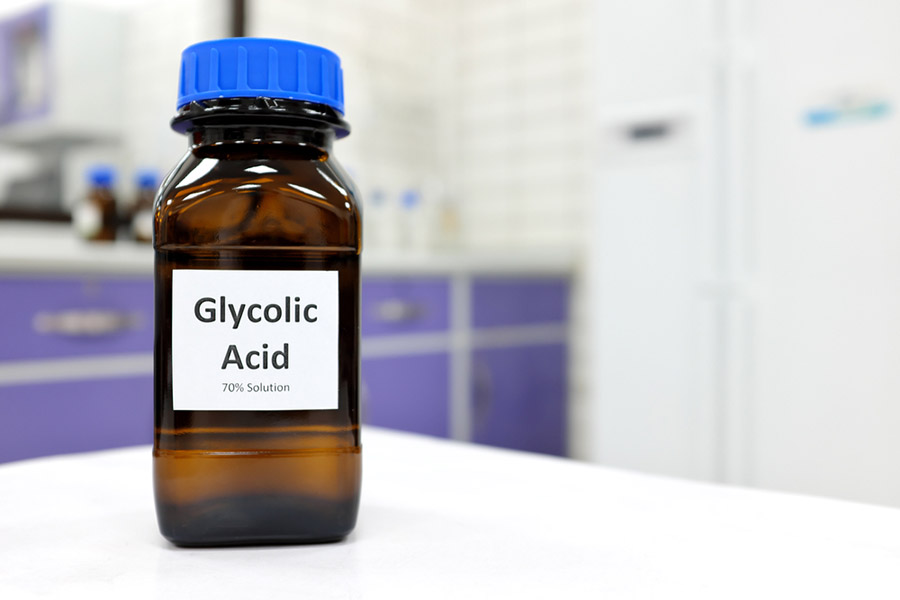What Is Glycolic Acid and How Is It Used?

By sulit.photos / Shutterstock.com
Glycolic acid has become one of the trendiest ingredients in skincare, but there’s still some confusion about what benefits it provides and how it’s actually used. In this quick primer, we’re covering what glycolic acid is and why you should use it, how you can incorporate this face exfoliator into your skincare routine and what skin types are most compatible with glycolic acid.
What is glycolic acid?
Glycolic acid is a member of the alpha hydroxy acid (AHA) family. AHAs are chemical exfoliants that are derived from milk or sugar origins. Chemical exfoliants work to exfoliate your skin by dissolving the chemical bonds that hold dead skin cells together (vs. physical exfoliants that scrub away the dead skin cells). While they might sound intimidating, chemical exfoliants such as glycolic acid are one of the safest and most effective ways to exfoliate your skin on a regular basis.
What are the benefits of glycolic acid?
One of the reasons for glycolic acid’s popularity is that it offers many benefits besides just effective exfoliation. By clearing away dead skin cells and helping to control oil production, glycolic acid can help to reduce acne breakouts. Glycolic acid also encourages your skin to produce more skin cells and more collagen, which can help minimize the appearance of fine lines and wrinkles. Finally, glycolic acid also promotes more even skin tone and may help with hyperpigmentation, melasma and related conditions.
Browse Our Anti-Aging Moisturizers
How is glycolic acid used?
Most people enjoy using glycolic acid in either a face peel or a leave-on treatment for the best exfoliating results. However, in the past few years, glycolic acid has become an extremely popular ingredient in skincare, so you can now find glycolic acid in facial cleansers, toners, serums, masks and more. There are even glycolic acid body lotions available if you want to treat the rest of your body as well as your face.
Always use glycolic acid products at night since they can make your skin more sensitive to the sun. You should also wear sunscreen during the day to protect your skin from potential UV exposure. Since glycolic acid is very strong, try using it only once per week and then potentially increasing the frequency to two to three times per week if your skin seems to need it. Keep it away from your eyes and from any cuts, abrasions or open sores on the skin.

By Prostock-studio / Shutterstock.com
How strong is glycolic acid?
Out of the most commonly used AHAs in skincare, glycolic acid has the smallest molecular size, which means that it’s actually one of the most powerful skincare acids you can use. The smaller the acid molecule, the more deeply it can penetrate your dead skin cells, resulting in more effective exfoliation. Because glycolic acid is so strong, you will rarely find leave-on products that contain more than 10 percent glycolic acid, while temporary peels may use up to 30 percent glycolic acid.
Note that the percentage of glycolic acid in a product is very important. Sometimes, skincare products will include a very tiny amount of an acid like glycolic acid to act as a pH balancer for other ingredients. Such a small amount of acid will not have the exfoliating properties that glycolic acid is known for because it’s just there to make the mixture more stable.
For best results, prioritize glycolic acids from brands that disclose the percentages on the label. You’ll want to look for a product that contains between five and 10 percent glycolic acid.

By Zigres / Shutterstock.com
Try Our Glycolic Acid Body Lotion
Who should try glycolic acid?
Because of its many benefits, glycolic acid is a great fit for several different skin types, most especially oily skin, combination skin and normal skin. If you have tried gentler chemical exfoliants — such as mandelic acid and lactic acid — with minimal results, then moving up to glycolic acid might be just what your skin needs.
However, due to its strength, glycolic acid is not a good fit for dry skin or sensitive skin. This particular AHA tends to be too stripping and irritating for these skin types. To start off, try a gentler AHA with a lower percentage instead, and then you can potentially look at branching into glycolic acid if your skin tolerates chemical exfoliation well.
At Lancer Skincare, we offer simple yet effective 3-step skincare regimens designed by celebrity dermatologist Dr. Harold Lancer. All of our products, including our glycolic acid peels, ship for free and come with a 30-day money back guarantee so you can buy with confidence. Shop our skincare routines to start achieving real results today.
 PREVIOUS (Can You Use Glycolic Acid with Reti...)
PREVIOUS (Can You Use Glycolic Acid with Reti...) NEXT (New Year, New You: Tips for Building the ...)
NEXT (New Year, New You: Tips for Building the ...)